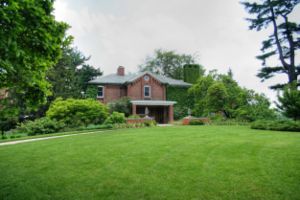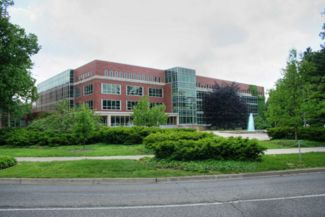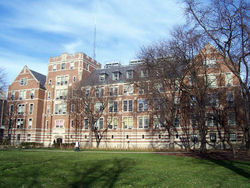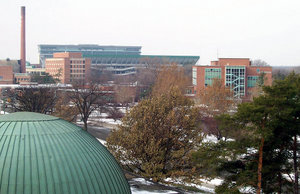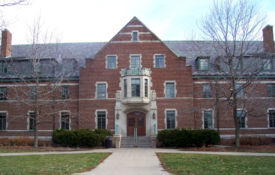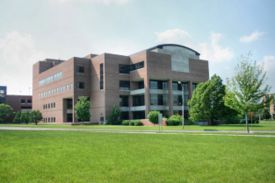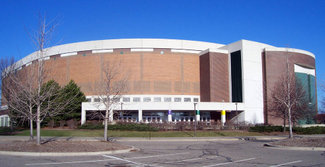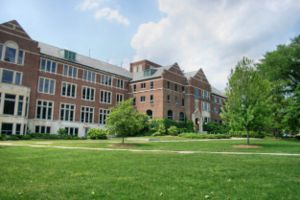Michigan State University
2007 Schools Wikipedia Selection. Related subjects: North American Geography
 |
|
| Motto | Advancing Knowledge. Transforming Lives. |
|---|---|
| Established | February 12, 1855 |
| Type | Public Land Grant University, Sea Grant |
| Endowment | $1.325 billion |
| President | Dr. Lou Anna Simon |
| Faculty | 2,311 |
| Students | 45,166 |
| Undergraduates | 35,678 |
| Postgraduates | 9,488 |
| Location | East Lansing, Michigan, USA |
| Campus | Suburban 5,200 acre (21 km²) campus 2,000 acres (8 km²) in existing or planned development |
| Sports | Spartans |
| Colors | Green and White
|
| Mascot | Sparty |
| Website | msu.edu |
 |
|
Michigan State University (MSU) is a public university in East Lansing, Michigan. Founded in 1855, it was the pioneer land-grant institution and served as a model for future land-grant colleges in the United States under the 1862 Morrill Act. It is the eighth-largest university in the United States, with 45,166 students and one of the top research universities in the world supporting no less than three medical schools. Listed as a Public Ivy, Michigan State is a member of the Association of American Universities.
Well known for its academic programs in education and agriculture, MSU pioneered the studies of packaging and music therapy. MSU is home to the second-oldest hospitality school in the United States, and the study abroad program is the largest of any single-campus university in the country, offering more than 200 programs in more than 60 countries on all continents including Antarctica.
Following the introduction of the Morrill Act, the college became coeducational and expanded its curriculum beyond agriculture. After World War II, the number of students tripled as the institution became a major university. As of 2005, MSU is the United States' sixth-largest university by enrollment. As a research university, MSU is one of 60 members of the Association of American Universities.
MSU's Division I sports teams are called the Spartans. They compete in the Big Ten Conference in all sports except ice hockey, in which the team is part of the Central Collegiate Hockey Association. MSU's football team won the Rose Bowl in 1954, 1956, and 1988. Its men's basketball team won the NCAA National Championship in 1979 and 2000.
History
Agriculture school
The Michigan Constitution of 1850 called for the creation of an "agricultural school", though it was not until February 12, 1855 that Michigan Governor Kinsley S. Bingham signed a bill establishing the United States' first agriculture college, the Agricultural College of the State of Michigan. Classes began in May 1857 with three buildings, five faculty members, and 63 male students. The first president, Joseph R. Williams, designed a curriculum that required more scientific study than practically any undergraduate institution of the era. It balanced science, liberal arts, and practical training. The curriculum excluded Latin and Greek studies, since most applicants did not study any classical languages in their rural high schools. However, it did require three hours of daily manual labor, which kept costs down for both the students and the College. Despite Williams' innovations and his defense of education for the masses, the State Board of Education saw Williams' curriculum as elitist. They forced him to resign in 1859 and reduced the curriculum to a two-year vocational program.
Land Grant pioneer
In 1860, Joseph Williams became acting lieutenant governor and helped pass the Reorganization Act of 1861. This gave the College a four-year curriculum and the power to grant master's degrees. Under the act, a newly-created body, known as the State Board of Agriculture, took over from the State Board of Education in running the institution. The College changed its name to State Agricultural College, and its first class graduated in the same year. However, there was no time for an elaborate graduation ceremony: the Civil War had just begun, and the first alumni were drafted into the war effort. The following year, Abraham Lincoln signed the First Morrill Act of 1862 to support similar colleges, making the Michigan school a national model. Williams never witnessed the cause to which he had dedicated so much of his life, having taken ill and died the previous year.
Co-ed college
The college first admitted women in 1870, although at that time there were no female dormitories. The few women who enrolled either boarded with faculty families or made the arduous stagecoach trek from Lansing. Nonetheless, even from the early days female students took the same rigorous scientific agriculture courses as male students. In 1896, the faculty created a "Women Course" that melded a home economics curriculum with liberal arts and sciences. That same year, the College turned the old Abbot Hall male dorm into a women's dormitory and more firmly established itself as co-ed. However, it was not until 1899 that the State Agricultural College admitted its first African American student, William O. Thompson. He went on to teach at what is now Tuskegee University under the wing of Booker T. Washington, whom President Jonathan L. Snyder invited to be the Class of 1900 commencement speaker. A few years later, Myrtle Craig became the first female African American student to enroll at the College. Along with the Class of 1907, she received her degree from U.S. President Theodore Roosevelt, commencement speaker for the Semi-Centennial celebration. The City of East Lansing was incorporated in that same year, and two years later the college officially changed its name to Michigan Agricultural College (M.A.C.).
Big Ten university
During the early 20th century, M.A.C. expanded its curriculum well beyond agriculture. By 1925, it had expanded enough that it changed its name to Michigan State College of Agriculture and Applied Science (M.S.C.). In 1941, the Secretary of the State Board of Agriculture, John A. Hannah, became president of the College. He began the largest expansion in the institution's history, with the help of the 1945 G.I. Bill, which helped World War II veterans to receive an education. One of Hannah's strategies was to build a new dormitory building, enroll enough students to fill it, and use the income to start construction on a new dormitory. Under his plan, enrollment increased from 15,000 in 1950 to 38,000 in 1965. Hannah also got the chance to improve the athletic reputation of M.S.C. when the University of Chicago resigned from the Big Ten Conference in 1946. Hannah lobbied hard to take its place, gaining admission in 1950. Five years later, in its Centennial year of 1955, the State of Michigan renamed the College as Michigan State University of Agriculture and Applied Science. Nine years after that, the University governing body changed its name from the State Board of Agriculture to the MSU Board of Trustees. The State of Michigan allowed the University to drop the words "Agriculture and Applied Science" from its name. Since 1964, the institution has gone by the name of Michigan State University.
Global leader by 2012
Since the end of the Hannah era, Michigan State has shifted its focus from increasing the size of its student body to advancing its national and global reputation. In recent years, " town and gown" relations have soured as students and permanent residents looked at each other with increasing hostility. Tensions worsened when East Lansing erupted in riots in 1997, and 1998,. The most recent disturbance occurred on April 2, 2005, after MSU's defeat to North Carolina in the 2005 men's basketball Final Four. Officially deemed a "civil disturbance" rather than a riot, the incident sparked a debate over police brutality in East Lansing, which has yet to be resolved. Despite the damage to MSU's image, the University looks to improve its academic reputation in the 21st century. In September 2005, current president Lou Anna Simon called for MSU, one of the public ivy institutions, to become the global model leader for Land Grant institutions by the year 2012. Her plans include creating a new residential college and increasing National Institutes of Health donations past the $100 million mark. While there are over 100 Land Grant universities in the United States, she has stated that she would like Michigan State University to be the leader.
Campus
MSU's sprawling campus is located in East Lansing on the banks of the Red Cedar River. The campus started in 1857 with three buildings: a multipurpose building called College Hall, a dormitory later called " Saints' Rest", and a barn. Today, MSU's contiguous campus consists of 5,200 acres (2,104 ha), 2,000 acres (809.4 ha) of which are developed. There are currently 676 buildings: 203 for academics, 154 for agriculture, 245 for housing and food service, as well as 74 other buildings. Overall, the University has 21,931,085 square feet (2,037,464.5 m²) of total indoor space. Connecting it all is 27 miles (43 km) of roads and 100 miles (161 km) of sidewalks. MSU also owns 44 non-campus properties, totaling 22,000 acres (8,903 ha) in 28 different counties.
North campus
The oldest part of campus lies on the north bank of the Red Cedar. It includes Collegiate Gothic architecture, plentiful trees, and curving roads with few straight lines. It was in this area that the College built its first three buildings, of which none survive. Other historic buildings north of the river include Cowles House, the president's official residence, and Beaumont Tower, a carillon clock tower marking the site of College Hall, the original classroom building. To the east lies Eustace-Cole Hall and Marshall-Adams Hall, America's first freestanding laboratories for horticulture and bacteriology, respectively. Other landmarks include the bronze statue of former president John A. Hannah, the W. J. Beal Botanical Garden, and the painted boulder known as " The Rock", which is a popular spot for theatre, tailgating, and candlelight vigils. On the northwest corner of campus lies the University's hotel, the Kellogg Hotel and Conference Centre.
South campus
The campus south of the river consists mostly of post-World War II International Style buildings with sparse foliage, relatively straight roadways, and numerous parking lots. The "2020 Vision" Master Plan proposes replacing these parking lots with parking ramps and green space, but these plans will take many years to reach fruition. As part of the master plan, the University erected a new bronze statue of " The Spartan" in 2005. This replica replaced the original modernist terra cotta statue, which can still be seen on the west concourse of the Spartan Stadium. Notable academic and research buildings on the South Campus include the Cyclotron and the College of Law. This part of campus is home to the MSU Horticulture Gardens and the adjoining 4-H Children's Garden. South of the gardens lie the Canadian National and CSX railroads, which divide the main campus from thousands of acres of university-owned farmland.
Academics
MSU has the sixth largest student body in the U.S. There are 45,166 total students, with 35,678 undergraduates and 9,488 graduate and professional students. The student body is 54% female and 46% male. While 89% of students come from all 83 counties in the State of Michigan, also represented are all 50 states in the U.S. and about 125 other countries. MSU has about 4,500 faculty and 6,000 staff members, and a student/faculty ratio of 19:1. Like other large American universities, MSU has a large number of teaching assistants teaching upper-level courses in certain disciplines.
Rankings
Michigan State ranks eightieth in the world, according to a Shanghai Jiao Tong University study, with U.S. News & World Report's ranking MSU 70th in the U.S. The university has over 200 academic programs, several of them highly-ranked. U.S. News has ranked MSU's graduate-level elementary and secondary education programs number one for the last eleven years. MSU's Industrial and Organizational Psychology Ph.D. program is another program ranked number one for the better part of the last decade. In U.S. News ' 2006 ranking of nuclear physics programs, MSU ranked second behind only MIT. Indeed, MSU’s Physics & Astronomy department ranks highly based on the number and impact of publications its faculty publishes. In addition to this, the 2007 U.S. News & World Report ranks Michigan State's Supply Chain Management program in the Eli Broad College of Business number one in the nation, beating out MIT (ranked second). The National Communication Association ranks MSU doctoral programs as the nation’s most effective in educating researchers in health communication and communication technology. MSU also is ranked in the top four in several other communication fields, including international/intercultural communication, mass communication and interpersonal communication. Other programs of note include criminal justice, music therapy, packaging, political science, and communications. MSU's study abroad program is the largest of any single-campus university in the United States with 2,461 students studying abroad in 2004–05 in over 60 countries on all continents, including Antarctica.
Research
The university spent $289,787,000 on research in 2002, capping a long history of productive research. In 1877, botany professor William J. Beal performed the first documented genetic crosses to produce hybrid corn, which led to increased yields. MSU dairy professor G. Malcolm Trout invented the process for the homogenization of milk in the 1930s. In the 1960s, MSU scientists developed cisplatin, a leading cancer fighting drug. Today Michigan State continues its research with facilities such as the U.S. Department of Energy-sponsored MSU-DOE Plant Research Laboratory and a particle accelerator called the National Superconducting Cyclotron Laboratory. In 2004, scientists at the Cyclotron produced and observed a new isotope of the element germanium, called Ge-60. In that same year, Michigan State, in consortium with the University of North Carolina at Chapel Hill and the government of Brazil, broke ground on the 4.1-meter Southern Astrophysical Research Telescope (SOAR) in the Andes Mountains of Chile. The consortium telescope will allow the Physics & Astronomy department to study galaxy formation and origins. Since 1999, MSU has been part of another consortium called the Michigan Life Sciences Corridor, which aims to develop biotechnology research in the State of Michigan.
The Michigan State University Library is the 26th largest academic library system in North America with over 4.7 million volumes and 6.4 million microforms. The university library comprises nine branch locations including the main library. The Africana Collection is one of the largest of its kind in the nation with a collection of over 200,000 items. Other significant collections include the G. Robert Vincent Voice Library, the largest academic voice library in the nation, containing a collection of over 40,000 hours of spoken word recordings and includes the voices of over 100,000 persons from all walks of life, and the Russel B. Nye Popular Culture Collections which includes the extensive Comic Art Collection. This collection includes over 100,000 comic books, and 10,000 related books and periodicals.
Endowment
MSU's (private, non-Morrill Act) endowment started in 1916 when the Engineering Building burned down. Automobile magnate R.E. Olds helped the program stay afloat with a gift of $100,000. While this opened the door for other types of private donations, MSU has often lagged behind peer institutions in terms of endowments. As recently as the early 1990s, MSU was last among the eleven Big Ten schools, with barely over $100 million in endowment funds. However, in the early 2000s, the University started a campaign to increase the size of the endowment. At the close of FY 2004–05, the endowment had risen to $1.325 billion, raising the University to sixth of the 11 Big Ten schools in terms of endowment; within $2M of the fifth-rated school. The rapid increase in the size of the endowment will help to improve outdated facilities, such as the Music Building, which the music department hopes to soon replace with money from its alumni fundraising program.
Colleges
Residential colleges
MSU has several residential colleges, based on the Oxbridge "living-learning" model. By putting classes in student domitories, these colleges improve student access to faculty and facilities. MSU's first residential college, Justin Morrill College started in 1965 with an interdisciplinary curriculum. MSU closed Morrill College in 1979, but today the university has two remaining residential colleges, with a third scheduled to start in 2007. Though these colleges started as an experiments, they are now well-respected programs.
Started in 1967, James Madison College tries to merge the best attributes of a small public affairs college and a major university. Classes in the college are small, with an average of 25 students, and most instructors are tenure track faculty. Each of Madison's three majors requires two years of foreign language and one year of "field experience” in an internship or study abroad program.Although Madison students make up about 4% of MSU graduates, they represent around 35% of the MSU’s Phi Beta Kappa members.
The Lyman Briggs School of Science teaches math and science within social, historical and philosophical contexts. Founded in 1967 as Lyman Briggs College, it was merged into the College of Natural Science in 1981, though the school is now trying to regain full College status. Many Lyman Briggs students intend to pursue careers in medicine, but the school supports over 30 coordinate majors, from human biology to computer sciences. Lyman Briggs is one of the few colleges that lets undergraduates teach as "Learning Assistants."
In 2007, MSU will accept its first class of students for the Residential College in Arts & Humanities. Founded October 21, 2005, the college will provide around 600 undergraduates with an individualized curriculum in the liberal, visual and performing arts. Though all the students will graduate with the same degree, MSU will encourage students in the college to get a second degree or specialization. The university will house the new college in Snyder-Phillips Hall, which it is currently renovating to make room for the new college.
Professional schools
The Michigan State University College of Law is a private law school, even though MSU is a public institution. Founded in Detroit in 1891 as the Detroit College of Law, MSU bought the school in 1995, and moved it to East Lansing. Students attending MSU College of Law come from 42 states and 13 countries. The law school publishes the Michigan State Law Review and several journals. Michigan State University College of Law is the home of the Geoffrey Fieger Trial Practice Institute, the first trial practice institute in the United States. The Intellectual Property and Communications Law program is ranked seventeenth nationally.
The Eli Broad College of Business has programs in accounting, information systems, finance, management, marketing and supply chain management, and hospitality business. The school has 4,775 undergraduate students and 776 graduate students. The Eli Broad Graduate School of Management, which Business Week magazine ranks 11th among public institutions, offers 3 MBA programs, as well as joint degrees with the College of Law.
Athletics

Michigan State's NCAA Division I-A program offers 14 varsity sports for men and 15 for women. Since their teams are called the Spartans, MSU's mascot is a Spartan warrior named Sparty. The university participates in the Big Ten Conference in all varsity sports except ice hockey, which competes in the Central Collegiate Hockey Association. The current athletic director is Ron Mason, who served as head hockey coach from 1979 to 2002, retiring with a record total of 924 wins, and a 608-261-64 record at MSU. MSU's Spartan Marching Band plays the fight song at every university event, and both students and alumni sing along. Michigan State is among only sixteen Division 1A programs to win multiple national titles in football, and the only school to win multiple national titles in both football and basketball. The Spartans have participated in two events, in basketball and ice hockey, which have set world records for spectator attendances for both sports.
Football
Football has a long tradition at Michigan State. Starting as a club sport in 1884, football gained varsity status in 1896. In the 1950s, MSU led the nation in desegregation, allowing black athletes in all sports. It won the Rose Bowl in 1954, 1956, and 1988. In 1967 the Spartans accounted for four of the top eight picks in the NFL draft, the only time a college football program has accomplished such feat.
Today, the football team competes in Spartan Stadium, a renovated 75,025 person football stadium in the centre of campus. The current coach is Mark Dantonio, who was hired on November 27, 2006. Dantonio had an 18-17 record in his three year tenure at the University of Cincinnati, including a 1-0 Bowl Game record. MSU's traditional archrival is the University of Michigan, against whom they compete for the Paul Bunyan Trophy. MSU is traditionally the underdog, with a 28-66-5 record in the annual game. Michigan State is one of three Big Ten teams to have an annual non-conference football game against Notre Dame. MSU's record against the Fighting Irish is 25-44-1.. Michigan State has won three (recognized) national championships and eight conference championships.
Men's basketball
MSU's men's basketball team has won the National Championship twice: in 1979 and again in 2000. In 1979, Earvin "Magic" Johnson, along with Greg Kelser, Jay Vincent, and Mike Brkovich, led the MSU team to a 75-64 win against the Larry Bird-led Indiana State Sycamores. In 2000, three players from Flint, Michigan, Morris Peterson, Charlie Bell, and Mateen Cleaves led the team to its second national title. Dubbed the "Flintstones", they were the key to the Spartans' win against the University of Florida. On December 13, 2003, Michigan State and Kentucky played in the Basketbowl, in which a record crowd of 78,129 watched the game in Detroit’s Ford Field. Kentucky won 79-74. The team currently plays at the Breslin Student Events Centre under head coach Tom Izzo, who has a 233-97 record. Izzo's coaching has helped the team make four of the last eight NCAA Final Fours, winning the title in 2000. In recent years, MSU's successes on the basketball court have been associated with riots that have received heavy press coverage and strained relations between the students and the permanent residents of East Lansing.
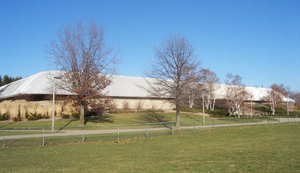
Men's Ice Hockey
The MSU men's ice hockey team started in 1924, though it has only been a varsity sport since 1950. The team has since won national titles in 1966 and 1986. They play at MSU's Munn Ice Arena. The current head coach is Rick Comley, who has a 34-19-3 record at MSU. Since the Big Ten Conference does not include Division I men's ice hockey, Michigan State competes in the Central Collegiate Hockey Association. Along with the University of Michigan and the Ohio State University, it is one of three Big Ten schools in the CCHA. As with other sports, the hockey rivalry between MSU and U-M is a fierce one, and on October 6, 2001 MSU faced UM in the Cold War, during which a world record crowd of 74,544 packed Spartan Stadium to watch the game end in a 3-3 tie.
Student life
East Lansing is very much a college town, with 58.6% of the population between the ages of 18 and 24. President John A. Hannah's push to expand in the 1950s and 1960s resulted in the largest residence hall system in the United States. 16,000 students live in MSU's 23 undergraduate halls, one graduate hall, and three apartment villages. Each residence hall has its own hall government, with representatives in the Residence Halls Association (RHA). Yet despite the size and extent of on-campus housing, 58% of students live off-campus, mostly in the " student ghettos" of East Lansing. One of these student-dominated neighborhoods is "Cedar Village". The city since has declared Cedar Village " blighted", and proposed to redevelop the 35 acre (14 ha) site as a complex of upscale condominiums and retail stores called East Village. Several fraternities in the affected area have mounted a campaign against the redevelopment plan.
Activism
Activists have played an important role in MSU history. During the height of the Vietnam War, student protests helped create co-ed residence halls, blocked the routing of Interstate 496 through campus, and led to the resignation of MSU President John A. Hannah. In the 1980s, Michigan State students convinced the University to divest the stocks of companies doing business in apartheid South Africa from its endowment portfolio, such as Coca-Cola. Today, MSU has many student groups focused on political change. The student government is the Associated Students of Michigan State University (ASMSU). It is known for its unusual nonpartisan bicameral structure, which includes the parallel Student Assembly and Academic Assembly. Graduate campus groups include the Graduate Employees Union (GEU) and the Council of Graduate Students (COGS). Michigan State also has a variety of partisan groups ranging from liberal to conservative, including the College Republicans, the College Democrats and several third party organizations. Other partisan activist groups include Young Americans for Freedom on the right and Students for Economic Justice and Movimiento Estudiantil Chicano de Aztlan ( MEChA) on the left. Given MSU's proximity to the Michigan state capital of Lansing, many politically-inclined Spartans get internships for the state representatives.
Greek Life
Michigan State University's greek system consists of around fifty Greek lettered student societies. These chapters are in turn under the jurisdiction of one of MSU's four Greek governing councils. Of these four, the Interfraternity Council (IFC) and the Women's Panhellenic Council are each entirely responsible for their own budgets, giving them the freedom to hold large fundraising and recruitment events. MSU's fraternities and sororities hold many philanthropy events and community fundraisers. Many chapters even hold two or three events per year. For example, in March 2006, the Greek system held Greek Week to raise over $170,000 for the American Cancer Society, Ele's Place, the Ronald McDonald House, and the Special Olympics.
People
The current president of the University is Lou Anna Simon, who took over on January 1, 2005, after being appointed by MSU's governing board, the Board of Trustees. The Board receives its mandate from the Michigan Constitution since MSU is a state-owned school. The constitution allows for eight trustees, elected by statewide referendum every two years. Trustees have eight-year terms, with two of the eight elected every other year. As of 2005, the Board is made up of five Republicans and three Democrats, and has a 4:4 gender balance.
19th century
Important College leaders in the 1800s include John C. Holmes, who kept the Agriculture School from being a part of the University of Michigan and is widely credited with being the prime mover for the school's founding, Joseph R. Williams, the first president, and T.C. Abbot, the third president who stabilized the College after the Civil War. Also of importance was botany professor William J. Beal, an early plant (hybrid corn) geneticist who corresponded with Charles Darwin and championed the laboratory teaching method. Another distinguished faculty member of the era was the alumnus/professor Liberty Hyde Bailey. Bailey was the first to raise the study of horticulture to a science, paralleling botany, which earned him the title of "Father of American Horticulture". Other famous 19th century graduates include Charles E. St. John, a prominent early astrophysicist and an associate of Albert Einstein, Ray Stannard Baker, a famed " muckraker" journalist and Pulitzer Prize winning biographer of Woodrow Wilson, and William Chandler Bagley, a pioneering education reformer. Prominent 19th century Japanese alumni include Minakata Kumagusu (1888), a renowned environmental scientist, and Michitaro Tsuda (B.S. 1884), who went on to become a member of the Emperor’s Privy Council.
20th / 21st centuries
Today, there are about 389,000 living MSU alumni worldwide. Famous MSU alumni include former Michigan governors James Blanchard and John Engler, Michigan U.S. Senator Debbie Stabenow, billionaire Eli Broad, and Teamsters president James P. Hoffa. Alumni in Hollywood include actors James Caan, Anthony Heald, Robert Urich, and Spider-Man director Sam Raimi. Also, two of the Little Rock Nine attended Michigan State, including Ernest Green, the first black student to graduate from Little Rock Central High School; and Carlotta Walls Lanier.
Spartans formerly or currently in the NBA include Earvin "Magic" Johnson, Steve Smith, Scott Skiles, Jason Richardson, Mateen Cleaves, Alan Anderson, Zach Randolph, Anthony 'Pig' Miller, Jumping Johnny Green, Paul Davis, Shannon Brown, Maurice Ager, Shawn Respert, Morris Peterson, and Charlie Bell. On the American Football League's All-Time Team are tight-end Fred Arbanas and safety George Saimes. In the National Football League, MSU alumni include Morten Andersen, Plaxico Burress, Andre Rison, Derrick Mason, Muhsin Muhammad, T.J. Duckett, Flozell Adams, Julian Peterson, Charles Rogers, Earl Morrall, Don Coleman, Sherman Lewis, Wayne Fontes and Bubba Smith. Former Michigan State players in the National Hockey League include Rod Brind'Amour, Anson Carter, Adam Hall, John-Michael Liles, brothers Kelly Miller, Kevin Miller and Kip Miller, as well as their cousin Ryan Miller.Former Michigan State players who formerly played or currently playing in Major League Baseball include Kirk Gibson, Steve Garvey, Robin Roberts, and Mark Mulder.


